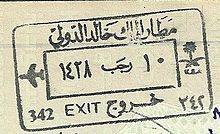Islamic calendar
[1] During that year, Muhammad and his followers migrated from Mecca to Medina and established the first Muslim community (ummah), an event commemorated as the Hijrah.[4][5][b] For central Arabia, especially Mecca, there is a lack of epigraphical evidence but details are found in the writings of Muslim authors of the Abbasid era.According to this view, Nasī' is related to the pre-Islamic practices of the Meccan Arabs, where they would alter the distribution of the forbidden months within a given year without implying a calendar manipulation.[6] The Encyclopaedia of Islam concludes "The Arabic system of [Nasī'] can only have been intended to move the Hajj and the fairs associated with it in the vicinity of Mecca to a suitable season of the year.This interpretation was first proposed by the medieval Muslim astrologer and astronomer Abu Ma'shar al-Balkhi, and later by al-Biruni,[8][14] al-Mas'udi, and some western scholars.In the tenth year of the Hijra, as documented in the Qur'an (Surah At-Tawbah (9):36–37), Muslims believe God revealed the "prohibition of the Nasī'".A few others (e.g., Turkey, Pakistan, Morocco, Nigeria, Malaysia) have adopted the Saturday-Sunday weekend while making Friday a working day with a long midday break to allow time off for worship.[32] or ربيع الأولى, rabīʿa l-ʾūlā or ربيع الآخر, rabīʿa l-ʾākhir or جمادى الأولى, jumādā l-ʾūlā or جمادى الآخرة, jumādā l-ʾākhirah or برات آی, bärât ay Twelver Shia Muslims believe the Islamic new year and first month of the Hijri calendar is Rabi' al-Awwal rather than Muharram, due to it being the month in which the Hijrah took place.[d] "As a result," says the Astronomical Almanac, "the cycle of twelve lunar months regresses through the seasons over a period of about 33 [solar] years".Thus, according to Islamic tradition, Abraha, governor of Yemen, then a province of the Christian Kingdom of Aksum of Northeast Africa and South Arabia, attempted to destroy the Kaaba with an army which included several elephants.The first ten years of the Hijra were not numbered, but were named after events in the life of Muhammad according to al-Biruni:[36] In c. 638 (17 AH), Abu Musa al-Ash'ari, one of the officials of the Rashid Caliph Umar (r. 634–644) in Basra, complained about the absence of any years on the correspondence he received from Umar, making it difficult for him to determine which instructions were most recent.According to him, the first day of the first month of the new fixed Islamic calendar (1 Muharram AH 1) was no different from what was observed at the time.This leaves only a small monthly variation of 44 minutes to account for, which adds up to a total of 24 hours (i.e., the equivalent of one full day) in 2.73 years.Determining the most likely day that the hilal could be observed was a motivation for Muslim interest in astronomy, which put Islam in the forefront of that science for many centuries.Nevertheless, the religious authorities also allow the testimony of less experienced observers and thus often announce the sighting of the lunar crescent on a date when none of the official committees could see it.However, the lunar crescent becomes visible only some 17 hours after the conjunction, and only subject to the existence of a number of favourable conditions relative to weather, time, geographic location, as well as various astronomical parameters.A number of Muslim countries try to overcome some of these difficulties by applying different astronomy-related rules to determine the beginning of months.[51][g][52] Thus the jurists Ahmad Muhammad Shakir and Yusuf al-Qaradawi both endorsed the use of calculations to determine the beginning of all months of the Islamic calendar, in 1939 and 2004 respectively.[57][58] The major Muslim associations of France also announced in 2012 that they would henceforth use a calendar based on astronomical calculations, taking into account the criteria of the possibility of crescent sighting in any place on Earth.Isma'ili-Taiyebi Bohras having the institution of da'i al-mutlaq follow the tabular Islamic calendar (see section below) prepared on the basis of astronomical calculations from the days of Fatimid imams.[61] Saudi Arabia has traditionally used the Umm al-Qura calendar, which is based on astronomical calculations, for administrative purposes.This ensures that the moon has moved past the sun by sunset, even though the sky may still be too bright immediately before moonset to actually see the crescent.In 2007, the Islamic Society of North America, the Fiqh Council of North America and the European Council for Fatwa and Research announced that they would henceforth use a calendar based on calculations using the same parameters as the Umm al-Qura calendar to determine (well in advance) the beginning of all lunar months (and therefore the days associated with all religious observances).Microsoft claimed that the variant is based on a statistical analysis of historical data from Kuwait, however it matches a known tabular calendar.[74] However, according to the 2006 Encyclopedia of the Developing World, "More confusing still is Qaddafi's unique Libyan calendar, which counts the years from the Prophet's birth, or sometimes from his death."[75] Reflecting on a 2001 visit to the country, American reporter Neil MacFarquhar observed, "Life in Libya was so unpredictable that people weren't even sure what year it was.



Solar Hijri calendarTabular Islamic calendarStar and crescentMondayGregorian calendarFebruary 3Sha'abanHebrew calendarShevatCoptic calendarTobi 26BahmanBengali calendarJulian calendarBeliefsOnenessAngelsRevealed BooksProphetsDay of ResurrectionPredestinationPracticesProfession of FaithPrayerAlmsgivingFastingPilgrimageFoundationsSunnahHadithTafsir (exegesis)IjtihadAqidah (creed)Qisas al-Anbiya ("Stories of the Prophets")MathnawiFiqh (jurisprudence)Sharia (law)HistoryTimelineJahiliyyahMuhammadAhl al-BaytSahabahRashidunCaliphateImamateSpread of IslamSuccession to MuhammadCulturesocietyAcademicsAnimalsAssociation footballChildrenCircumcisionDemographicsDiasporaDenominationsEconomicsEducationEthicsExorcismFeminismFestivalsFinanceLiberalismMadrasaMoral teachingsMosqueMysticismPhilosophyPoetryPoliticsProselytizingScienceSexualitySlaveryConcubinageSocial welfareApostasyCriticismArabic languageOther religionsIslamismViolenceterrorismIslamophobiaJihadismSalafi jihadismDeobandi jihadismMilitary lawsGlossaryKing Khalid International AirportArabicromanizedlunar calendarlunar monthsIslamic holidaysannual fastinggreat pilgrimagecivil calendarSyriac month-namesJordanLebanonPalestineHijri eraIslamic New YearMedinaHijrahTimeline of Islamic historyPre-Islamic calendarAbbasidSouth Arabianlunisolar systemal-Birunial-Mas'udiTihamahProcopiussummer solsticeQur'anKinanahpre-IslamicIbn HishamIbn ManzurQur'anic exegesisSabaic